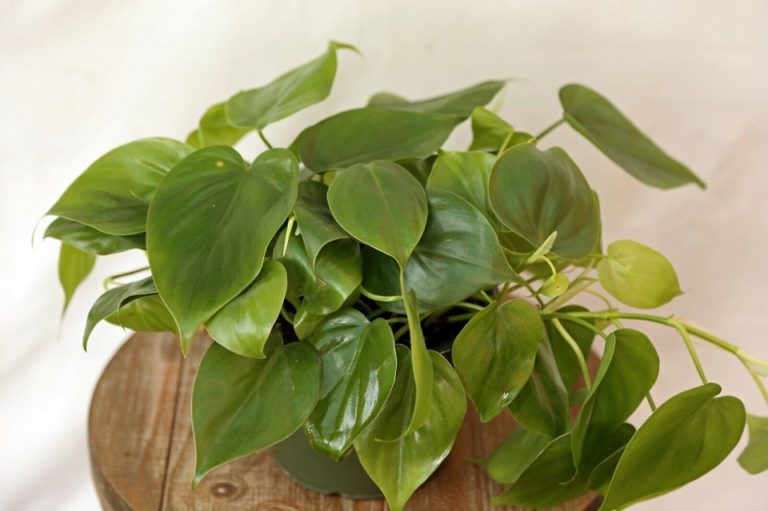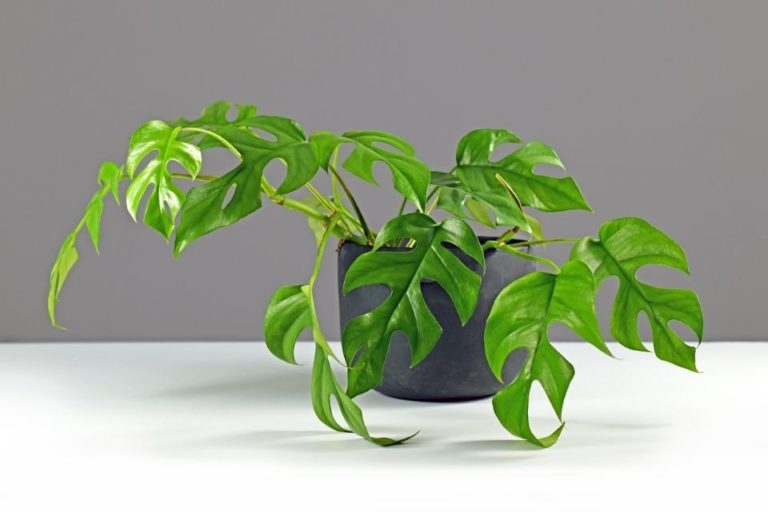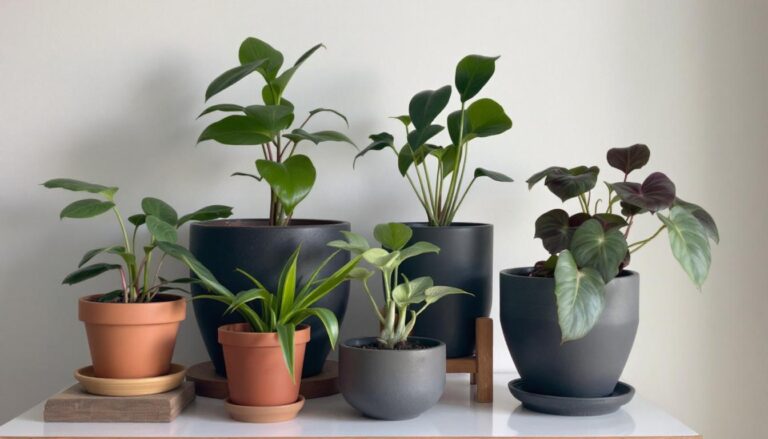Philodendron Gloriosum Care: How To Plant, Grow, Care & Propagate
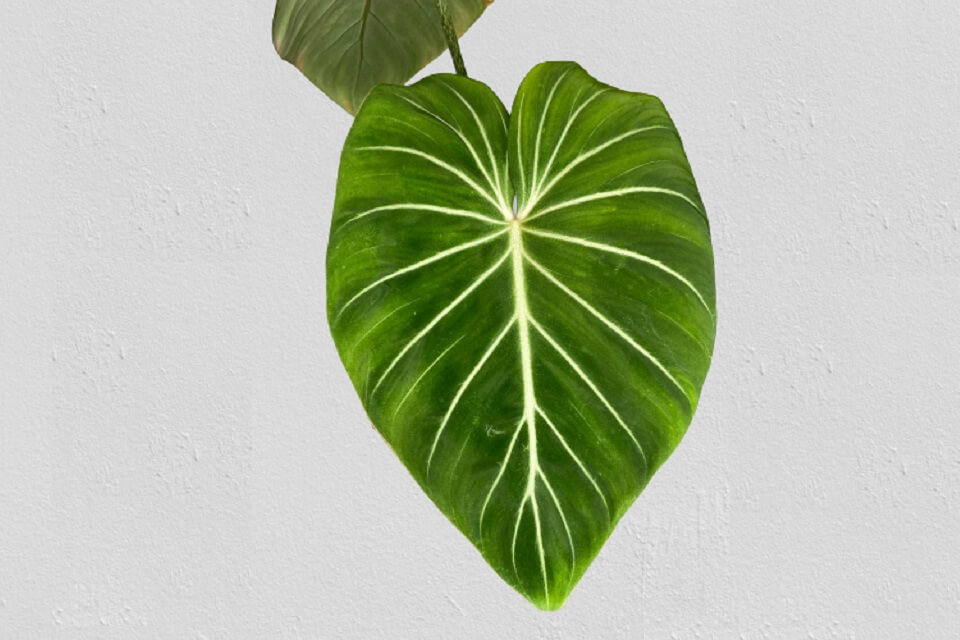
Philodendron Gloriosum is a plant species that belongs to the family Araceae and genus Philodendron. It is a creeper plant that grows by crawling on the ground and spreading horizontally rather than trailing and climbing.
The origin of its name is from the Greek language; Philo means “love” and “Dendron” is a tree. The meaning aligns well with its heart-shaped leaves.
The leaves are characterized by velutinous surfaces with pale green and pink margins and distinct pink or white veins, giving them a complete solemn aura. As a result, many plant lovers worldwide have been smitten with this plant.
This article will share how to care for, grow and propagate your Philodendron Glorriosum. If you are planning to grow this plant, this is the right place. Keep reading the article to find out all the information you need.
TABLE OF CONTENTS
Philodendron Gloriosum Overview
Philodendron Gloriosum is a native plant to Colombia and its terrestrial. Apart from Colombia, you will find it in tropical areas in Venezuela, the west part of Brazil, Ecuador, Peru, Central America, and Mexico.
Furthermore, the natural habitat of this plant is a humid environment that is warm with an average temperature between 65 to 85 degrees Fahrenheit (18 to 29 degrees Celsius).
In native conditions, this plant grows slowly compared to White Knight and White Wizard. It will take one to two months for the leaves to unfurl entirely and grow to a height of 24 to 36 inches height and spread.
Moreover, this plant has been listed as “vulnerable” by the International Union for Conservation of Nature as the most endangered natural plant species.
Philodendron Gloriosum is a flowering plant that blooms, making it look like flowers of the aroid species. The flower has a flowering spike known as a spadix and a leaf bract known as a spathe.
However, this plant does not bloom indoors, especially without proper maintenance. But in the native tropical habitat, it is likely to flower.
Uses Of Philodendron Gloriosum
The Philodendron Gloriosum has numerous uses such as air purification, decorating spaces, and rope making.
Decoration of Spaces:
It is used to decorate empty indoor spaces in offices, hotels, homes, and restaurants. They are appealing and eye-catching and add charm to the indoor spaces making them lively.
Furthermore, they do not have many pest problems and need less maintenance, making them an excellent choice for an indoor plant.
Air Purification:
The Philodendron Gloriosum is a great air purifier. Not only does it absorb carbon dioxide in the air, but it also absorbs formaldehyde, benzenes, and trichloroethylene, usually given off from synthetic building material, plastics, and new carpets.
All houseplants are not equal; the ones with more surface area are better air purifiers than those with less surface area. Moreover, houseplants are the most preferred by many plant lovers because they effectively clean the air in your home.
Rope Making:
When the leaves of this plant dry, they are not thrown away; they are used to make fiber ropes and baskets. The basket can be used as home décor or a fruit basket.
Best Placement
The best place to position this plant is to choose a spot with optimum filtered light. Make sure it is a warm place free from cold drafts. You should not place the plant on the west or south-facing windowsill; the sunlight may be intense.
Instead, it would be best if you used a screen or a curtain sheer to filter the intensity of the light and prevent leaf scorch.
Size & Appearance Of Philodendron Gloriosum
Philodendron Gloriosum is a slow-growing indoor plant. The formation of leaves may take a month. The indoor plant leaves grow up to 20cm or 24 inches in length. The stems can grow up to 1 meter or 3 feet in length.
However, in their natural condition, these plants’ leaves can grow up to 36 inches in length and the stem can grow up to 6 feet or 2 meters in length.
The Philodendron Gloriosum has a cordate leaf with velvety green foliage whose veins are white or pink—giving it a distinct feature that makes it look beautiful and easy to notice whenever it is in a room.
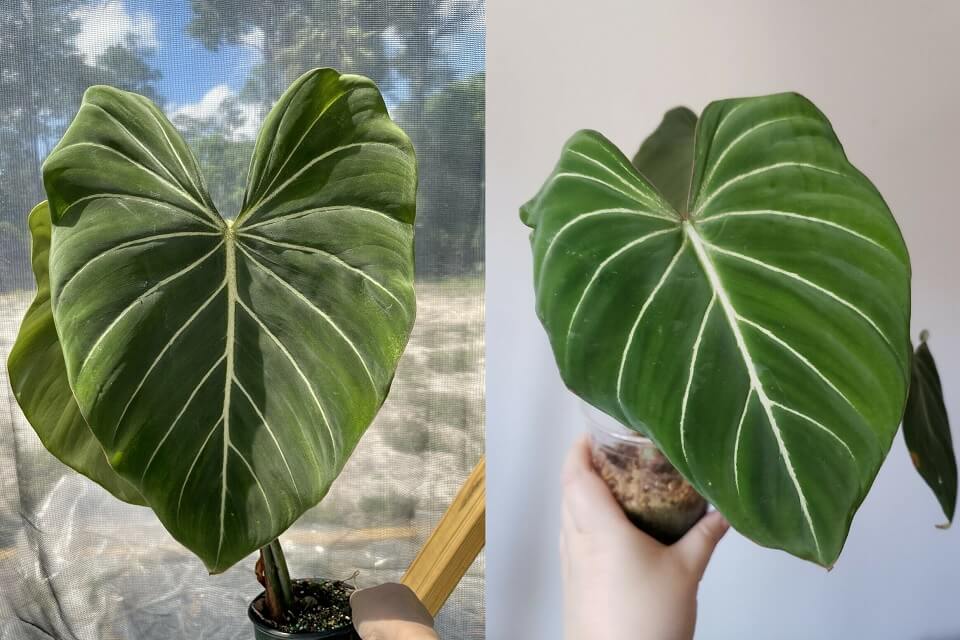
Additionally, the stems grow near each other and in one order. If your plant has stems that have grown apart or have leggy stems, you need to cut some of the stems and water the plant properly.
Philodendron Gloriosum Growth Rate
The Philodendron has a slow-growing rate indoors. It takes time before it develops a new leaf. It may take one or two months to grow a leaf fully. However, this plant tends to mature faster while in its natural habitat.
Philodendron Gloriosum Care
Taking care of Philodendron Gloriosum is very easy; you do not need to have any experience in houseplants. To grow and maintain a healthy Philodendron Gloriosum plant, you must understand the fundamentals of how to care for this houseplant.
Below is important information you use to take of your plant
– Soil Requirement
Philodendron Gloriosum plant thrives in well-draining soil which has organic matter. The soil should have high aeration because of the roots of this plant.
Moreover, the best potting mix for this plant is a few grams of worm or casts, peat moss or peat coco, and perlite.
Coco peat ensures the plant gets the correct amount of moisture for an extended period. The worm cast or compost helps the plant to acquire nutrients. It also increases the soil’s physical properties and improves the soil’s organic matter.
Additionally, perlite improves soil porosity leading to better aeration and drainage. If you discover the potting mix is soaked, you can improve the drainage by adding more perlite, sand, orchid barks, and charcoal to the content mix.
To efficiently remove the excess water from the pot, ensure the potting mix is well-drained.
– Watering Philodendron Gloriosum
The Philodendron Gloriosum thrives in moist soil. But you have to ensure that the soil does not become overwatered and saturated. A soggy, overwatered and swampy soil may make the plant roots rot.
To ensure your plant receives the appropriate amount of water, you will water in less quantity and more frequently. If the soil does not drain, the roots are likely to suffocate, and eventually, they will rot.
Therefore, the roots will not absorb water from the soil and distribute it to the rest of the plant; hence the leaves will turn yellow and droop. Also, if the water is less, the plant leaves will droop because of dehydration.
To prevent both under-watering and overwatering, you can check manually how much thirsty your plant is and when to water it. You do this by putting your finger one to two inches deep into the soil.
If the soil is dry, you can water your plant, but if the soil is wet, it has enough moisture.
– Light And Exposure
The origin of Philodendron Gloriosum is the tropical rainforest. These plants usually grow beneath the evergreen trees that provide them with shade. You can imitate this natural condition by providing them with bright indirect sunlight.
By doing this, you will be mimicking their natural habitat; hence the plant will grow healthy. Moreover, you can expose the plant for a few minutes to direct sunlight.
However, if exposed for long periods, the plant will burn its leaves and scorch. With the burnt leaves, the plant will not shine because the foliage is the part of the plant that shines.
Therefore, keep your plant facing east or on the east window during the morning; it will get some direct sunlight that is not harsh and will receive bright indirect sunlight during the day.
You can use a glowing light when placing insides, but natural light is the most preferred
– Temperature Needs
Philodendron Gloriosum plant grows well at 13 degrees Celcius to 27 degrees Celcius (65°F to 79°F). At night the temperature should range between 16 degrees Celcius to 20 degrees Celcius (60°F to 69 °F).
The plant grows actively in the spring and summer, but in winter the growth rate slows down.
– Humidity Requirements
Philodendron Gloriosum flourishes in humid conditions. Higher humidity makes the plant look greener and fresher. The ideal humidity levels are 60%, although the plant can survive in 40 to 45% moist conditions.
The humidity of the plant’s environment is increased in the following ways.
- Use a humidifier to make the surroundings humid.
- Use a pebble tray containing water and keep your pot inside there
- Use a sprayer to mist your plant from time to time
- Find a naturally humid spot or place, for example, the bathroom, but make sure there is enough sunlight for the plant
- Group the plants; their combined effect of transpiration will lead to a humid atmosphere
– Fertilizing Philodendron Gloriosum Plant
The best fertilizers to use are organic fertilizers for your Philodendron Gloriosum plant. Synthetic fertilizers are not recommended for the plant.
Organic fertilizers improve the soil’s organic matter, leading to the improvement of both the chemical and physical properties of the soil. It makes the ecosystem of the plant to be sustainable.
Moreover, you should apply the correct amount of organic fertilizer to your plant. You can use fertilizers twice or once a month at a quarter or half the recommended dose, especially during the growing season.
During winter, only apply the fertilizer once after every two months
– Pruning
Pruning of Philodendron is done when you come across yellowing or drying leaves. Also, it is done to manage the size and shape of your plant.
Furthermore, cutting stem and back leaves is an excellent way to enhance growth from nodes. When you are pruning your plant, cut it at the stem near the base and then water the plant after pruning to regain its strength.
How To Re-Pot Philodendron Gloriosum Plant?
Philodendron Gloriosum plant grows slowly indoors, so it may not need regular repotting like the other houseplants. The best time to do repotting is during summer because, during this time, it is thriving.
Signs that it is time to repot your plant
- Poor water retention
- Visible roots on the soil
- Yellow leaves
- Leggy and reduced growth
Steps Of Repotting
Step 1:
Prepare your workstation or work area with the following essentials: a new plant pot, water, fresh potting mix, protective gloves, and newspaper to cover the work surface.
The gloves are meant to protect you from skin irritation when working the plant since it is toxic.
Step 2:
Select a larger pot than the previous pot. The Philodendron Gloriosum creeps on the ground; therefore, a deep round pot is unsuitable because it will have small space to crawl.
The more available the space for crawling is, the less you will be required repotting.
Step 3:
Fill the pot halfway with soil. Use a draining potting soil or make your own. Ensure it has perlite to increase drainage and peat moss for moisture retention. After that, use your fingers to make a well for the roots in the soil.
Step 4:
Remove the plant from the old pot into your hand. Gently remove the plant from the pot and brush off the extra soil, using three fingers to detangle the roots with caution. Then look for signs of disease or root rot.
If you see slimy or black mushy roots, use a clean pair of scissors or knife to trim off the root system. Wipe the cutting with alcohol after trimming each section to avoid the spread of bacteria to other parts of the roots.
Step 5:
Place your plant into the soil. After you have inspected the roots and you are satisfied, put the roots in the soil, then fill the pot with a fresh potting mix.
Ensure you place the rhizome on the upper part of the soil; this helps avoid root rot. Water the plant thoroughly and place it back in its correct spot.
Philodendron Gloriosum Propagation with Steps
Propagation is done through stem cutting and is easy to propagate Philodendron Gloriosum compared to other Philodendrons. Philodendron Gloriosum first grows the rhizome which develops into leaves and roots.
When you are stem cutting, make sure to cut it at the rhizome. By doing so, the part that you will cut will have some already grown roots.
The following is a step-by-step guide to help you propagate your plant successfully.
Step 1: Find The Correct Spot To Cut
This is the most crucial step. You should cut a section that contains a rhizome between two leaves. By doing this, you will be ensuring that you have some developed roots and that further growth of the stem is assured.
When cutting the stem, ensure that you leave three leaves behind. A rhizome is enough; it is not essential to have a leaf during stem cutting.
Step 2: Cut The Rhizome
After you have done a stem cut with a rhizome, go ahead and cut it evenly and allow it to stay for a while until it starts developing a callous. Callous development typically takes several hours.
Step 3: Let The Rhizome Heal
It would be best to allow the rhizome to heal before being planted in the pot. You can fasten the healing process by sprinkling cinnamon powder on the wound. Cinnamon is a disinfectant that prevents the wound from infections.
Step 4: Prepare The Pot
Take a pot that contains drainage holes and put moist sphagnum moss. Make sure that your soil is damp, not wet.
Step 5: Plant The Cutting
After you have prepared the pot, plant the stem into the soil. Be gentle when carrying out this process because the rhizome’s roots are delicate and you should avoid damaging them. Do not plant the rhizome deep in the soil. Make sure it is close to the surface because being planted deep in the moist soil will lead to the rhizome rotting.
Step 6: Maintain Humidity Levels
After that, cover the pot using plastic or keep it in a plastic container so that a humid environment is created, which is ideal for growth. Then open the lid of the container or mouth of the plastic to ensure the air inside stays fresh it does not stale.
Step 7: Provide The Necessary Warmth
After creating a humid environment for the plant, you need to ensure the plant gets the optimum temperature for growth by putting a heating map beneath the plastic container. The warmth will speed the process of growth. It will take two to four weeks for the leaves and roots to grow.
Step 8: Transfer Your Plant To The Planting Pot
Use a rectangular pot and put moist potting soil. After the stem has grown, many roots and, two or three leaves move it from the sphagnum moss pot to the pot having the potting soil.
Step 9: Let The Plant Grow
After step 8, you have successfully repotted your Philodendron Gloriosum; let it grow. Ensure you provide it with all necessities for optimum growth, such as light, water, humidity, and the right temperature.
Common Diseases, Pests Problems, And Prevention
All plants suffer from attacks from pests and diseases; this is because of pests like the juicy green leaves. They will always attack in large numbers when they find a tasty stem sap.
Spider Mites
A sign that spider mites are attacking your plant is that the foliage will turn pale or yellow. They attach their white webs that are visible on the leaves. To get rid of spider mites on your plant, you can spray it with a showerhead or spray bottle.
After that, spray the plant using a solution of neem oil. Repeat this process after two weeks and you be sure that your plant will be free from spider mites.
Aphids
Aphids attack or damage new leaf growth by sucking its sup. To eliminate them, make your insecticidal soap by mixing ten milliliters of dish soap and one quart of warm water.
Using a spraying bottle, spray your homemade insecticidal soap on the upper and lower surfaces of the leaf.
Other pests that like attacking the Philodendron Gloriosum, include fungus gnats, and mealybugs. They affect the general appearance of the plant and suck sup out the plant.
Regularly inspecting and monitoring the plant is the best way to prevent the infestation of pests on your plant.
Root rot
If your plant’s leaves are unfurling, are yellow, or smaller, it is due to rotting. It happens when the soil is too wet and has poor aeration. So if the soil stays wet for long and does not dry, it will lead to the rotting of the roots.
Always inspect the roots for rotting by checking the stem. If you find a rotten part, cut it away, wash the rest of the root and transplant them in fresh soil. The pot should have drainage holes to ensure proper aeration.
Yellow Leaves
If the leaves turn yellow, it could be due to excessive exposure to sunlight or overwatering. You should check your plant to ensure it is placed at the right spot. Too much exposure to direct sunlight burns the leaves.
Check the frequency of how you water your plant. Water the plant only when the soil appears to be dry and check the soil mix to ensure it is draining correctly.
Dropping Of Leaves
Sometimes the leaves drop because of the wrong watering pattern. You should re-visit the watering routine to ensure that the water is not excess or little.
If the watering is extra, reduce the frequency and if the plant has been missing water, start watering it frequently.
Torn Leaves
If the leaves of your plant are tearing apart, it is because of insufficient moisture and humidity, making them brittle. The remedy to this problem is improving humidity content in the plant environment.
You can also put the pot in a tray containing wet pebbles or mist the plant after a couple of hours.
Leggy Stems
Leggy stems are common in plants; the stems grow far apart or leggy in an attempt to get some light due to insufficient sunlight. You solve this problem by changing the position of the pot so that it receives enough indirect sunlight.
FAQs
Is Philodendron Gloriosum A Suitable Houseplant For Beginners?
Yes, it is suitable for beginners. It is easy to care for; it only requires a little attention to grow healthy and its foliage shines.
You need to provide the necessary conditions for its growth, such as warmth, bright indirect light, and a humid environment. Remember to have a good watering program and to fertilize the plant.
Does Philodendron Gloriosum Climb?
No, it does not climb. These plants are ground creepers and do not climb moss poles or trellises. The stem grows straight as it crawls along the ground in its natural habitat.
How Do You Make Gloriosum Leaves Bigger?
You can make the leaves grow bigger by ensuring it receives bright indirect sublight warmth, the correct amount of water, and keeping a humid environment full of fresh air and use of fertilizer during the growth period.
Additionally, you can repot the plant whenever the roots become bound.
Is Philodendron Gloriosum Toxic To Pets Or Humans?
The Philodendron Gloriosum stems and leaves have insoluble calcium oxalates that are harmful to humans and pets if ingested. The visible signs of exposure are swallowing difficulties, drooling, and swelling lips, throat, and tongue.
Do Philodendron Gloriosum Flower?
Yes, it flowers. It is a flowering plant. Its buds appear like aroid plants. The flower has a leaf bract known as a spathe and a flowering spike known as a spadix. In their native tropical habitat, these plant produces flowers.
Can I Grow Philodendron Gloriosum Under Grow Light?
Yes, you can grow Philodendron Gloriosum under grow light. However, the most recommended light is bright indirect sunlight to achieve optimal growth and reach its fullest potential.
Under the grow light, the plant will grow but at a slower rate than exposing it to indirect sunlight.
Can I Grow Philodendron In A Greenhouse?
Yes, you can grow it in a greenhouse so long as you meet all the conditions necessary for growth. Remember to give the plant the little attention it requires to ensure it thrives.
Where Can I Buy A Philodendron Gloriosum?
You can buy this plant from online stores, websites, and nurseries and you can be sure it will be delivered to your home. The only thing you have to do is to order this beautiful plant in advance as sometimes stock gets limited.
Take Away
Philodendron Gloriosum is a beautiful plant that breathes life to empty spaces. However, they require a moderate care level to ensure healthy houseplants.
You need to ensure that the plant environment is balanced with adequate light, toasty humid temperatures, and nutritious soil; this allows the plant to be velvety soft and magnificently green.
Lastly, do not feel left out because the plant needs a moderate care level. Even if you are a beginner with no prior experience with houseplants, this article is an excellent guide for beginning your journey with this plant.



